Titian
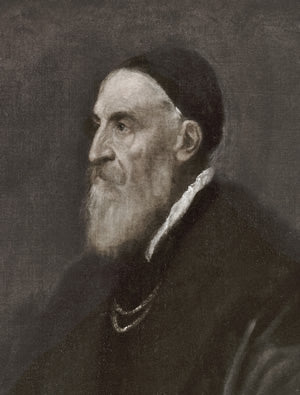
| Birth name: | Titian Vecelli (or Vecellio). |
|---|---|
| Artistic name: | Titian. |
| Nationality: | Italy |
| Year of birth: | Around 1490, Pieve di Cadore, Veneto, Italy. |
| Year of death: | 1576, Venice. |
| Period: | High Italian Renaissance |
| Styles: | Renaissance, Mannerism, Venetian School |
Known for his decisive, energetic, and very expressive brushstroke, the Renaissance painter Titian Vecellio, also called simply "Titian," was the most distinguished member of the Venetian school. He masterfully handled asymmetrical and non-hierarchical compositions. Many of the foundational elements of his style were forged from the ideas of the great master Giovanni Bellini. After his death, Titian evolved and continued to modernize them throughout his life.
Paintings by Titian
There are many cases in history where painters are recognized posthumously, but Titian is not one of them; quite the opposite, he was acknowledged by his own peers as a great master. He was versatile in his expertise for different genres and themes: portrait, landscape, altarpiece, historical painting, biblical scenes, allegory, mythology, naturalism, etc.
-
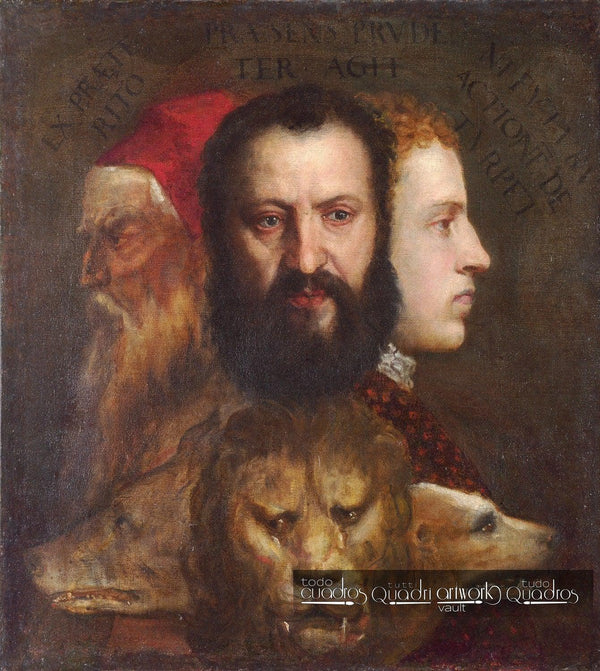
Author: TitianYear: circa 1570Located at: The National Gallery, LondonStyle: RenaissanceOriginal title: Allegoria della PrudenzaTitle (English): Allegory of PrudenceType: PaintingTechnique: OilSupport: CanvasA conceptual work full of symbolism, where the author wants to manifest his idea about the ages of man and their characteristics.
There is no official or unique interpretation among experts, but all agree that it exalts the figure of man at his point of maturity, as of the three represented, he is the only one who looks at the present and possesses the virtue of prudence.
Technically, this allegory is a portrait of 3 people plus 3 animals, the figures and lighting are realistic.
At the top, three phrases can be read:
"EX PRAETERITO", "PRAESENS PRUDENTER AGIT" and "NE FUTURA ACTIONẼ DETURPET".
They respectively mean:
"From the past", "Prudence in the present" and "Do not spoil future actions". -
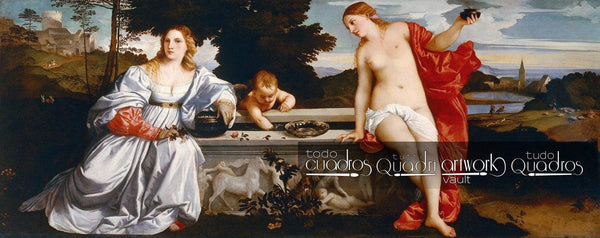
Author: TitianYear: circa 1514Located at: Borghese Gallery, Rome.Style: MannerismOriginal title: Amor sacro e Amor profanoType: PaintingTechnique: OilSupport: CanvasA composition with a mythological theme, it has been the subject of numerous interpretations, often contradictory. The symbolic elements it includes are: a carved fountain (in the center), 2 hares, Cupid (central child figure), fortified construction (left), church (right).
-
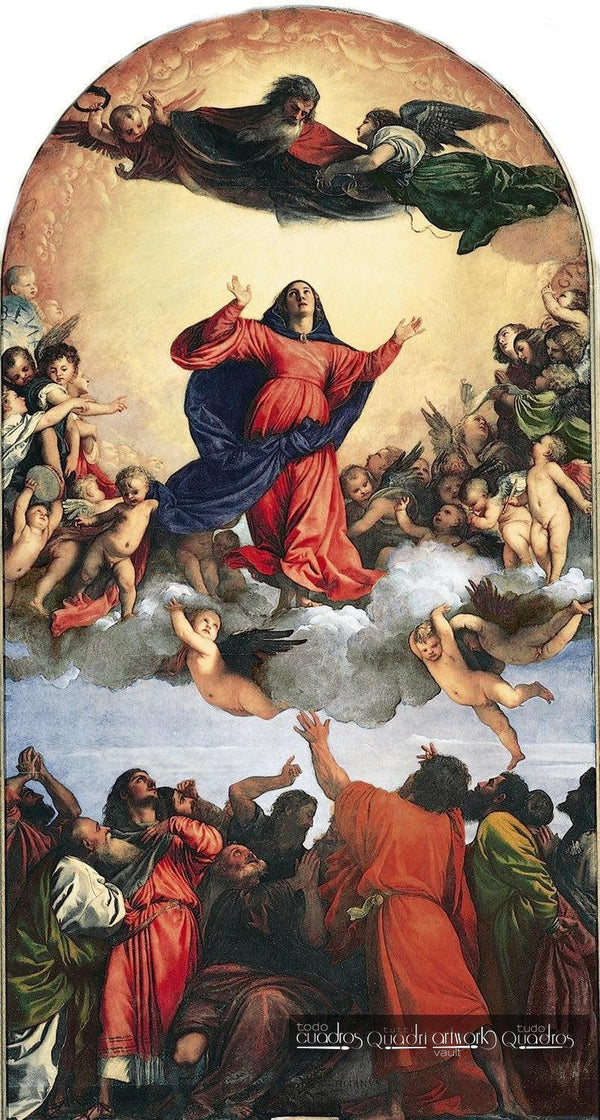
Author: TitianYear: circa 1518Located at: Santa Maria dei Frari Basilica, Venice.Style: RenaissanceGenre: AllegoryOriginal title: AssuntaType: PaintingTechnique: OilSupport: Wood panelThis is the largest oil painting in Venice to this day and remains in the original location where it was painted. This work was largely responsible for catapulting Titian's fame in the region, though not without controversy, as many close to the congregation had serious doubts about the quality of the painting.
An allegorical altarpiece that depicts the Assumption of the Virgin Mary, the moment when she was taken by God to heaven, body and soul, as described in Christian tradition. It is considered a model work of the Italian Renaissance style.
In the lower layer, the apostles symbolize those still living in the world, crying out to heaven for her intercession. The central figure of the Virgin, walking on clouds, is completely surrounded by little angels and cherubim. In the upper part, God the Father appears, illuminated and looking downward, accompanied by two angels.
-

Author: TitianYear: circa 1520Located at: The National Gallery, LondonStyle: MannerismTheme: Greek MythologyOriginal title: Bacco e AriannaTitle (English): Bacchus and AriadneType: PaintingTechnique: OilSupport: CanvasThis mythological themed painting was originally commissioned by Duke Alfonso I d'Este to Raphael Sanzio, who died having barely started it. The purpose of the work was to decorate a room in one of the Duke's residences.
It depicts a literary episode, where the god Bacchus (or Dionysus), descends from his chariot to attract the beautiful daughter of kings Ariadne.
Here Titian demonstrates his superlative skill as an anatomist, drawing the most diverse creatures, human, semi-human, and animals.
-
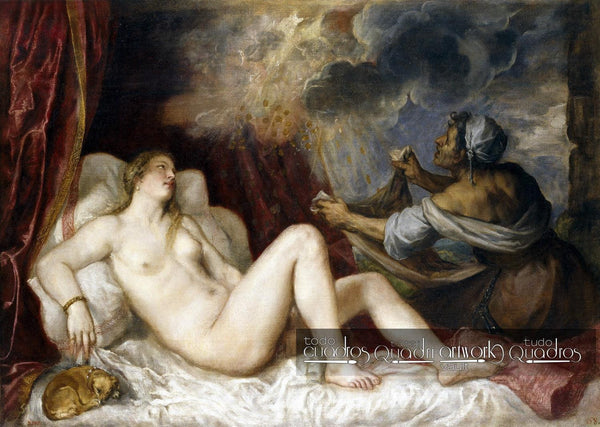
Author: TitianYear: 1565Located at: Prado MuseumStyle: MannerismOriginal title: DanaeType: PaintingTechnique: OilSupport: CanvasThis is a portrait of Danae, the character from Greek mythology, in a scene extensively treated by the artist throughout his career.
This particular copy was acquired by Diego Velázquez himself, who was a public admirer of Titian and considered him one of his main pictorial references.
-
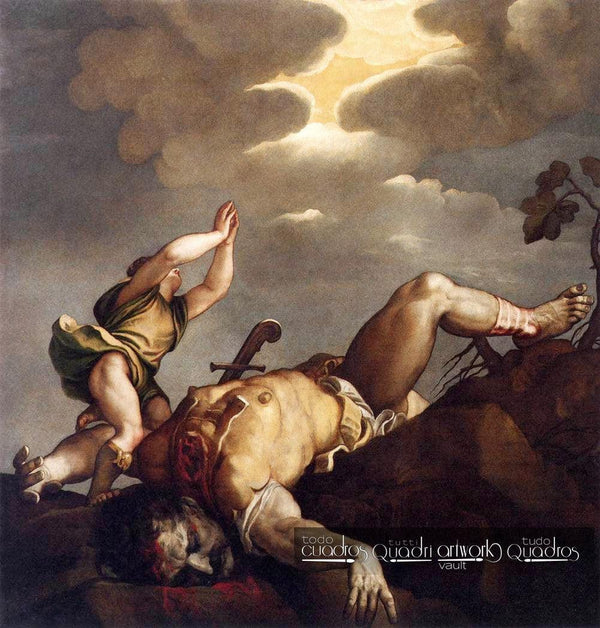
Author: TitianYear: circa 1542Located at: Basilica of Santa Maria della Salute, Venice.Style: MannerismOriginal title: Davide e GoliaType: PaintingTechnique: OilSupport: CanvasThis is one of the three works Titian painted to be installed on the ceiling of the basilica. The other two depict "Cain and Abel" and "The Sacrifice of Isaac."
In a fire in 2010, it suffered water damage during extinguishing efforts, but was almost fully recovered.
The scene's viewpoint is from below, giving more prominence to the sky and the ray of light appearing among the clouds. The iconography used is very unusual in this biblical scene, as it shows David praying to heaven after having defeated the giant.
-

Author: TitianYear: circa 1514Period: High RenaissanceTitle in English: Christ and Mary Magdalene (Noli me tangere)Type: PaintingTechnique: OilSupport: CanvasBelongs to the artist's earliest period, strongly imbued with the purest Venetian school. It shows the often-painted biblical passage, where Mary Magdalene wants to cling to the Lord upon seeing him resurrected, to which he says:
"Do not touch me, for I have not yet ascended to the Father. Go and tell my brothers..." -
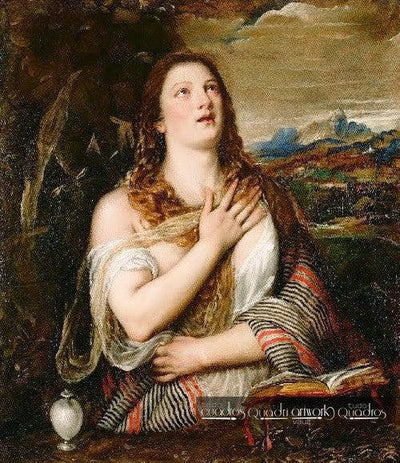
Author: TitianYear: circa 1560Located in: J. Paul Getty Museum, California.Style: High RenaissanceTitle in English: The Penitent MagdaleneType: PaintingTechnique: OilSupport: CanvasThis is one of at least 7 very similar versions where Titian portrayed the same biblical character. In the time of the Counter-Reformation, when the Catholic Church was experiencing one of its greatest schisms following the emergence of Protestantism. Images like this were intended to exalt the origins and traditions of Catholicism.
This particular version was used by the artist as a model for the others. X-ray studies have revealed a large number of changes, indicating that it was preserved and retouched over several years.
-
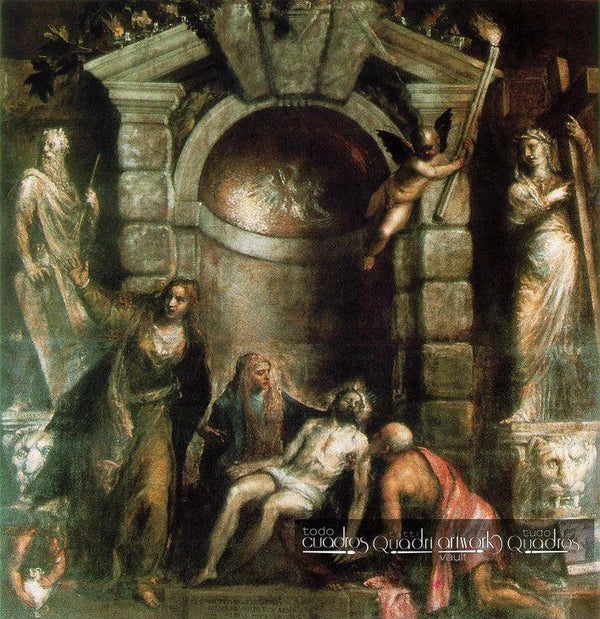
Author: TitianYear: circa 1575Located in: Academy Gallery, Venice.Style: RenaissanceOriginal Title: PietàType: PaintingTechnique: OilSupport: CanvasThis is known to be the last painting created by Titian, which was finished by his disciple known as Palma the Younger after Titian's death.
It depicts an imaginary scene of 5 biblical characters in a Roman-style architectural setting. The characters form a perfect Kepler triangle, ascending from left to right: Moses, Mary Magdalene, The Virgin Mary, Jesus, and Nicodemus.
-

Author: TitianYear: circa 1547Located in: National Gallery of Art (NGA), Washington, D.C., USA.Style: High RenaissanceEnglish Title: Saint John the Evangelist on PatmosType: PaintingTechnique: OilSupport: CanvasA large work meant to be displayed high up, it is notable for its decisive brushwork on the figures and diffuse background, characteristic of the artist.
-
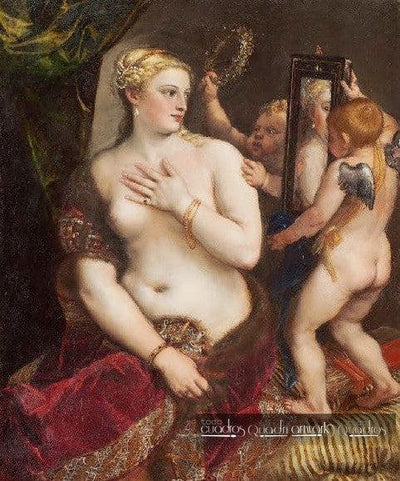
Author: TitianYear: 1555Located in: National Gallery of Art (NGA), Washington, D.C., USA.Style: High RenaissanceOriginal Title: Venere allo specchioEnglish Title: Venus with a MirrorType: PaintingTechnique: OilSupport: CanvasThe artist created this motif several times during his career, with this version considered the most complete. It depicts a scene from Roman mythology, where the goddess Venus (of love and beauty) admires herself in a palatial setting, assisted by a pair of angels, one of whom is crowning her while the other holds the mirror.
-
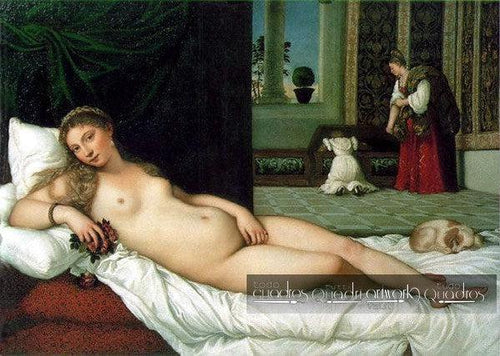
Author: TitianYear: 1538Located in: Uffizi Gallery, Florence.Style: MannerismAlso known as: Venus of the Little DogOriginal Title: Venere di UrbinoEnglish Title: Venus of UrbinoType: PaintingTechnique: OilSupport: CanvasThis work oscillates between reality and mythology. Contrary to what the title suggests, the protagonist is actually a flesh and blood person, as symbolized by the dog curled up at her feet. In the background, two maids are seen in a setting that borders on the idyllic.
Buy it in the section of Titian oil paintings
Related famous painters:
- El Greco
- Leonardo da Vinci
- Jan van Eyck
- Peter Paul Rubens
- Giotto di Bondone
- Bartolomé Esteban Murillo
↑Back to top
